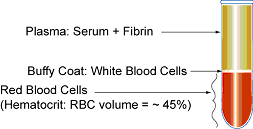Blood Basics
Physical Properties of Blood and Plasma
How much blood is in the human body?
The average adult has a blood volume of approximately 5 liters, which comprises about 8% of the body's weight. The osmolality (concentration of solutes in water) of blood is 275-295 milliosmoles per kg.
What is blood plasma?
Plasma is the straw-colored liquid component of blood. It is a protein-salt solution and acts as a suspension for red and white blood cells and platelets.
What is plasma made of?
Plasma constitutes approximately 55% of blood's volume and is comprised of:
- 90% Water
- 8% Protein
- 0.9% Inorganic Salts
- Sodium 135-146 mM
- Potassium 3.5-5.2 mM
- Calcium 2.1-2.7 mM
- Carbonate 23-31 mM
- Phosphate 0.7-1.4 mM
- 1.1% of organic substances
The protein content of plasma
It is estimated that plasma may contain as many as 40,000 different proteins from about 500 gene products. Approximately 1,000 proteins have been detected.
Plasma contains three major types of proteins: albumins, globulins, and fibrinogens.
- Albumins are the most abundant protein group present in blood plasma.
- Globulins can further be divided into α1, α2, β1, β2, and γ-globulins.
- Fibrinogen is the plasma protein coagulation factor.1
- The plasma proteins can be classified by their functionalities into three classes: proteolytic enzymes, protease inhibitors, and carrier proteins.
- Plasma contains 50-70 mg of protein per ml
- Approx. 70% Albumin (35-50 mg/ml)
- Approx. 10% IgG (5-7 mg/ml)
Blood Composition on the Cellular Level
For every 600 red blood cells, there are approximately 40 platelets and one white cell.
Red Blood Cells (Erythrocytes)
- Typically 4-8 x 106 cells per µl
- Composed approx 90% hemoglobin
- RBCs have a life-span of approx. 120 days before they are removed by the spleen

Figure 1.Blood Composition
Platelets (Thrombocytes)
- Typically 150,000-350,000 per µl
- Produced by megakaryocytes stimulated by thrombopoietin.
- Platelets circulate for an average of 9-10 days before removal by the spleen.
- Participate in hemostasis/coagulation
White Blood Cells (Leukocytes)
Neutrophils (polymorphonuclear leucocytes)
- Phagocytic
- Compose approximately 56% of the white blood count
- Chemotactic-directed phagocytic action in response to interleukin-1 from macrophages, histamine from basophils, mast cells, and platelets and complement proteins C3a and C5a in the plasma.
Eosinophils
- Phagocytic & Cytotoxic
- Compose approximately 4% of the white blood count.
- Bind via C3b receptors resulting from parasitic alternative pathway complement activation.
- Granules release proteins cytotoxic to parasites: MBP, peroxidase, arylsulphatase B, phospholipase D, and histaminase.
Basophils
- Smallest granulocytes
- Non-Phagocytic
- Compose approximately 3% of the white blood count.
- Involved in Type I hypersensitivity
- Binding of IgE to the Fc receptors on basophils stimulates the release of histamine and heparin
- Upon stimulation, basophils release TNF- and IL-4, which modulate endothelial adhesion molecules.
- Basophils express integrins as receptors to the endothelial membrane proteins ICAM-1, ELAM-1and VCAM-1
Lymphocytes
- Compose approximately 25% of the white blood count
- Produced by the bone marrow.
- Termed B cells when they achieve immune-competence within the marrow
- Termed T cells when they achieve immune-competence within the thymus
- B Cells respond to antigens by the production of antibodies, B and T cells produce lymphokines that control the immune response
Monocytes
- Within approximately one day from being produced in the marrow, monocytes are transported to various organs where they become tissue macrophages via the influence of cytokines.
- kidney - mesangial cells
- bone - osteoclasts
- liver - Kupfer cells
- brain - microglia
Reference
계속 읽으시려면 로그인하거나 계정을 생성하세요.
계정이 없으십니까?